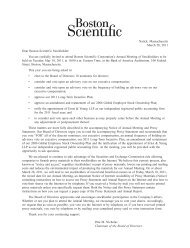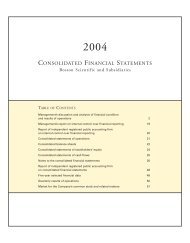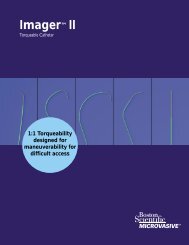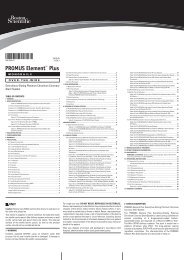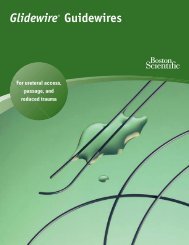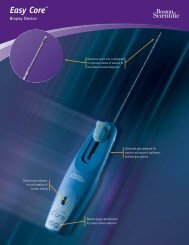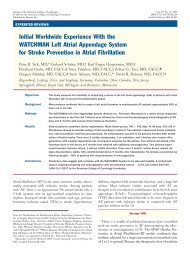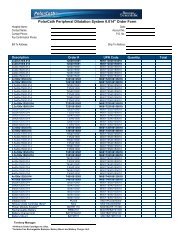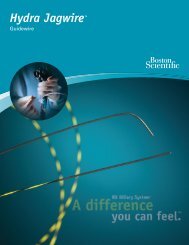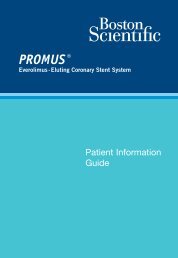Physician Reimbursement Primer for Cardiac ... - Boston Scientific
Physician Reimbursement Primer for Cardiac ... - Boston Scientific
Physician Reimbursement Primer for Cardiac ... - Boston Scientific
You also want an ePaper? Increase the reach of your titles
YUMPU automatically turns print PDFs into web optimized ePapers that Google loves.
Chapter 3<br />
At this time there is no specific NCD <strong>for</strong> CRT-Ds. However, some Medicare contractors<br />
have developed LCDs <strong>for</strong> CRT-D that apply to certain regions. It is important <strong>for</strong> medical<br />
providers to check with their local Medicare contractor or non-Medicare payers to<br />
determine patient coverage and coding/billing guidelines.<br />
Medicare NCD <strong>for</strong> Intracardiac Electrophysiology and<br />
Related Procedures<br />
Some cardiovascular procedures, such as pacemakers and cardioverter defibrillators,<br />
contain very clear national coverage criteria as defined by CMS. Other procedures, such<br />
as electrophysiology studies (EPS), do not have clearly defined coverage criteria at the<br />
national level. Some Medicare contractors have developed LCDs <strong>for</strong> EPS that apply to<br />
certain regions. It is important <strong>for</strong> providers to check with their local Medicare contractor<br />
or non-Medicare payers to determine patient coverage and coding/billing guidelines.<br />
Note: Search the Medicare Coverage Database on the CMS website<br />
(http://www.cms.hhs.gov/mcd/search.asp) <strong>for</strong> coverage descriptions and updates.<br />
ICD National Coverage<br />
In the requirements <strong>for</strong> new ICD coverage, Medicare distinguishes between primary<br />
prevention of sudden cardiac death, meaning patients with no history of induced or<br />
spontaneous arrhythmia, and secondary prevention, meaning patients with a<br />
documented cardiac arrest or sustained ventricular tachyarrhythmia. For patients meeting<br />
the primary prevention indications, the providers (hospitals and physicians) must be able<br />
to justify the medical necessity of devices other than single-lead devices. This medical<br />
necessity must be documented in the patient’s medical record.<br />
National Coverage <strong>for</strong> Device Follow-up<br />
There is an NCD <strong>for</strong> cardiac pacemaker evaluation services (post implant). There is no<br />
NCD, however, <strong>for</strong> ICD or CRT evaluation services (post implant). In the absence of<br />
national coverage guidelines, providers should consult their local Medicare contractor’s<br />
guidance.<br />
Code descriptors <strong>for</strong> the new 2009 CPT codes relating to cardiac device monitoring<br />
indicate minimum frequencies <strong>for</strong> in-person and remote monitoring 10 . As Medicare<br />
establishes local coverage policies around these codes, frequency will become a focal<br />
point <strong>for</strong> coverage. The Heart Rhythm Society (HRS) and the European Heart Rhythm<br />
Association (EHRA) have published the HRS/EHRA Expert Consensus on the Monitoring<br />
of Cardiovascular Implantable Electronic Devices (CIED): Description of Techniques,<br />
Indications, Personnel, Frequency and Ethical Considerations. This document makes<br />
recommendations <strong>for</strong> follow-up based on the type of cardiac device and may be helpful<br />
as a guide to reimbursement billing practices. It is available online at<br />
http://www.hrsonline.org/Policy/<br />
ClinicalGuidelines/upload/cieds_guidelines.pdf<br />
20 <strong>Physician</strong> <strong>Reimbursement</strong> <strong>Primer</strong> <strong>for</strong> <strong>Cardiac</strong> Rhythm Management



